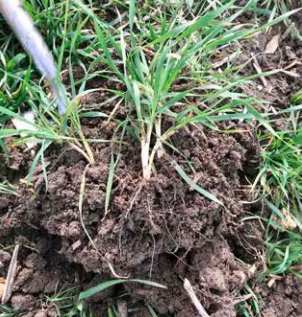Written by Steve Holloway from Soil Fertility Services Ltd
A soil test will give you numbers and guidelines of where your soil is and hopefully where it should aim for to consider it ‘balanced’ (note I didn’t say healthy); remember that it’s NOT an N-P-K world. Sensible soil nutrition is the first step toward higher crop quality and yields. Testing will measure levels of various elements within the soil such as Calcium (C) and Magnesium (Mg) which are two of the main building blocks of soil aggregation; high levels of either will have a negative effect of how well the soil functions. Mulders chart shows the interactions of soil nutrients (how one nutrient influence another), for example – too much nitrogen can reduce the plant’s ability to take up Potassium, Boron and Copper increase Potassium and reduce the availability of Magnesium.
This effect is known as antagonism. Calcium is a bit of a bully in the soil where antagonism is concerned; when levels are high Manganese (Mn), Magnesium (Mg), Potassium (K), Phosphate (P), Iron (I), Boron (B) and Zinc (Zn) are all affected. However, calcium is needed in plants as a building block and is vital as the ‘cement’ that holds cells together and produces stability for plant cell structure. Silica, although not readily plant available from within your soil, is also important for increasing the physical strength of plants and in turn the plant’s natural resilience to pest and disease pressures.
Having established a soil test shows the mineral makeup of your soil and a specific number of anions/cations relative to the elements measured, from there you can identify where your soil sits when compared to the ideal’ target range. But is that a healthy’ soil?

Many of the measured elements will not yet be available to your crop, if they were, the greedy plants would gorge on this deluge of goodies and make themselves sick while most unclaimed nutrients would volatilise or be washed away. It has to be a balancing act of what’s available and what can be ‘made available’. Within the soil, various elements hold onto each other, dictated by whether the element is positively charged (cation) or negatively charged (anion). This is how nutrients are ‘locked up.’ These bonds can be broken by the root microbes or by the environment. Humic and Fulvic acid are referred to as chelators; they improve the delivery and efficacy of foliar applied nutrients, forming strong bonds with trace elements and enabling the direct uptake of nutrients across the plant leaf with reduced risk of leaf burn.
When bonded with Humates, applied nutrients are kept plant available in the root zone, reducing nitrogen leaching and phosphorus lock-up.
Imagine how much healthier your soils could be with the addition of Humic acid. With a cation exchange capacity (CEC) of 300-500, an increased available water capacity up to 30-50% more, on top of that you get improved soil quality due in part to increased activity of the beneficial bacteria building better soil aggregates. Biological activity plays a key part in the soil/plant relationship and as such trades commodities with the plant, releasing tied up nutrients for plants to utilise. So, you could say the numbers in a soil test mean very little if you don’t have ‘the biological army’ around the root to support and maximise nutrient availability. A healthy soil will have balance; excesses and deficiencies – physical or biological can have a negative influence. Measuring and monitoring your soil and plant on a regular basis will highlight potential problem areas, for example: you test the soil and are low in (x) but when you test the plant you are not low in (x) is there an issue?
You get the lab to test for biological activity, and a result comes back with a high rating, so is everything ok? Are those organisms beneficial? What percentage? A decision made with blinkers on is not a decision it’s a leap of faith! Longer term assessment must be a part of your farming system; know your history to plan your future, be prepared to throw the rule book out the window. The soil test doesn’t tell you what’s in the plant, the plant analysis doesn’t tell you what is in the soil – you need both.
Soil Fertility Services was established in the 1990’s and has since been working hand in hand with farmers throughout the UK, constantly striving to find biological farming solutions that are efficient and more effective, in order to build soil fertility and provide crop nutrition.